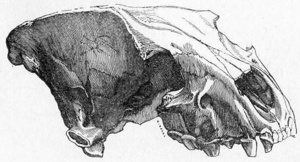The hyena is one of many animals that features quite prominently in folklore around the world. Like the hare, it is often seen as a clever animal; unlike the hare, however, the hyena is also often seen as being quite foolish. Many African stories include both animals, in which the hyena plays several mean tricks on the hare, though the hare always gets the best of the hyena in the end.
This pattern of the hyena being duped into failure is also evident in the American south, specifically Louisiana, where Bouki the hyena is as much an antagonist as the big bad wolf or the sly fox is in stories from other parts of the U.S. The hyena in these stories, while often bigger and stronger than its adversary, is always outsmarted by the adversary-Lapin the rabbit in Bouki’s case-who either exploits the hyena’s gullibility or cleverly outmaneuvers its short-sighted thinking.
Such stories praise the hare as an admirable underdog, while reviling the hyena as a cunning villain. It is not difficult to understand why. The hare is a peaceful herbivore and a valuable food item, regarded as intelligent, moral and clean. The hyena is well known for eating decomposing carrion, as well as being a predatory killer. The mottled pattern in the spotted hyena’s coarse coat is repulsive to many African peoples, and their scruffy appearance and mud-wallowing habits further adds to their perceived uncleanliness. The way they move, with their front legs being longer than their back ones, contrasts sharply with the movements of the swift and nimble hare. Finally, the unnerving “laughter” of the hyena, along with unnaturally ambiguous appearance of the spotted hyena’s genitals (commonly misinterpreted as hermaphroditism) firmly puts them-in the opinions of many-in the company of witches and devils.
It’s not surprising, then, that apart from being simply silly brutes, hyenas are also often evil entities in folklore. In Angola, Kishi (also Nkishi or Mukishi) is an evil spirit, a demon with two faces on its head. One face is that of a handsome man, which lures young women near; the other face is a hyena, which eats them. In northern Nigeria, Kuri is a black hyena spirit who causes paralysis. A 1376 Persian medical treatise warned of the kaftar, werehyenas that slaughtered children, though this term modernly refers to the hyena only. The werehyena is a common figure in much of Africa; in Nigeria, they are called the bultungin, which means “I change myself into a hyena.” In many places, hyenas are thought to be witches’ familiars, the witch riding on its back at night, or clutching it about the middle as fire shoots out behind it to propel it forward.
Brutish or clever, silly or sly, misguided or downright evil, the misunderstood hyena has been the subject of fear and scorn, and the representative of the most unpleasant of human traits, for as long as it has been included in the myths and stories of the people around it.
Sources:
1. Beidelman, T.O. “Ambiguous Animals: Two Theriomorphic Metaphors in Kaguru Folklore.” Africa: Journal of the International African Institute, Vol. 45, No. 2. Edinburgh University Press, 1975.
2. Gaudet, Marcia. “Bouki, the Hyena, in Lousiana and Africa Tales.” The Journal of American Folklore, Vol. 105, No. 415. American Folklore Society, 1992.
3. Bleek, Dorothea F. “Bushman Folklore.” Africa: Journal of the International African Institute, Vol. 2, No. 3. Edinburgh University Press, 1929.
4. Frembgen, J.W. “The Magicality of the Hyena: Beliefs and Practices in West and South Asia.” Asian Folklore Studies, Vol. 57. 1988.


